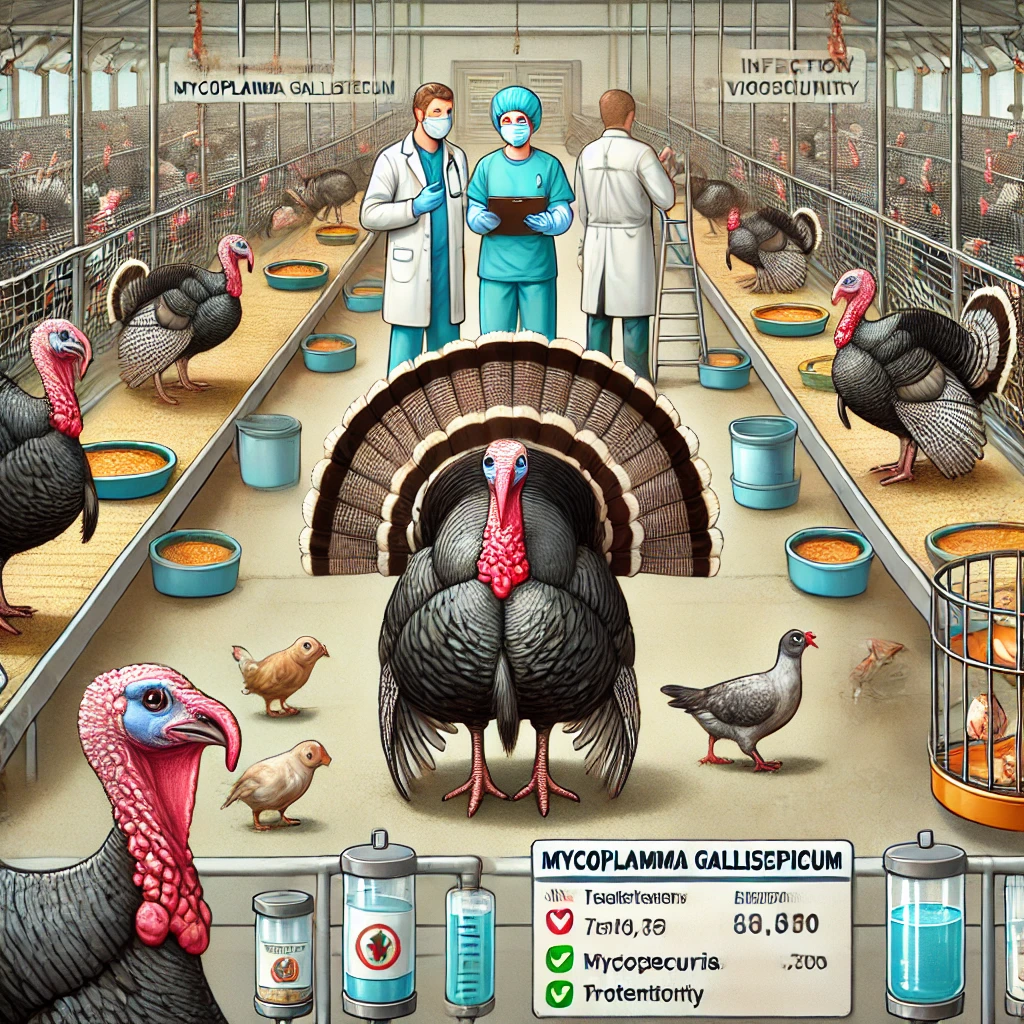Introduction
Mycoplasma gallisepticum (MG) is a contagious bacterial infection that affects poultry, including turkeys, chickens, and game birds. The disease can significantly impact poultry health and production, causing respiratory problems, decreased egg production, and increased mortality. In turkeys, mycoplasma gallisepticum turkeys infections can spread rapidly, leading to severe economic losses, especially in large flocks. Understanding how MG manifests, spreads, and can be controlled is essential for poultry farmers and veterinarians alike.
In this detailed guide, we will explore the symptoms, transmission, diagnosis, treatment, and prevention strategies associated with mycoplasma gallisepticum turkeys. We will also cover the importance of biosecurity measures and vaccinations to prevent outbreaks and ensure the well-being of your turkey flock.
The Nature of Mycoplasma Gallisepticum
Mycoplasma gallisepticum belongs to the class of Mycoplasmataceae, a group of bacteria that lack a cell wall. This characteristic makes them resistant to antibiotics that target cell wall synthesis, such as penicillin. Mycoplasma gallisepticum turkeys infections can become chronic if untreated, leading to ongoing health problems in affected birds.
The bacterium primarily targets the respiratory system, causing inflammation in the trachea, air sacs, and sinuses of turkeys. As the infection progresses, it can lead to secondary bacterial infections, further complicating treatment. MG is also known to compromise the immune system, leaving turkeys more susceptible to other diseases.

Symptoms of Mycoplasma Gallisepticum in Turkeys
Infected turkeys often exhibit respiratory symptoms, which are the hallmark of mycoplasma gallisepticum turkeys infections.
- Nasal discharge and sneezing
- Swelling around the eyes and sinuses
- Coughing and wheezing
- Labored or open-mouth breathing
- Decreased appetite and lethargy
- Drop in egg production in breeding turkeys
- Stunted growth in young poults
In some cases, turkeys may develop secondary infections, such as bacterial sinusitis or pneumonia, which can exacerbate symptoms. Chronically infected turkeys may become carriers of the bacteria, spreading the disease to healthy birds even if they no longer exhibit symptoms.
Transmission and Spread of Mycoplasma Gallisepticum
Mycoplasma gallisepticum turkeys infections are highly contagious, spreading rapidly through direct and indirect contact. The primary modes of transmission include:
- Aerosol Transmission: Infected turkeys release bacteria through respiratory secretions, which can contaminate the surrounding air and infect other birds in close proximity.
- Direct Contact: Healthy turkeys can contract the infection through direct contact with infected birds.
- Contaminated Equipment: Feeders, waterers, and handling equipment can become contaminated with the bacteria, facilitating its spread.
- Vertical Transmission: Infected breeding hens can transmit the bacteria to their offspring through the egg.
The spread of mycoplasma gallisepticum turkeys infections is often accelerated in overcrowded or poorly ventilated housing conditions, where birds are in close contact. Stress, such as changes in temperature, poor nutrition, or transport, can also trigger outbreaks by weakening the immune response of turkeys.

Diagnosis of Mycoplasma Gallisepticum in Turkeys
Accurate diagnosis is crucial to managing and controlling mycoplasma gallisepticum turkeys infections. Veterinarians rely on several diagnostic tools to confirm the presence of MG. Clinical signs, such as respiratory distress and swelling around the eyes, often prompt further investigation. Diagnostic methods include:
- Serological Tests: These tests detect antibodies against MG in blood samples, indicating exposure to the bacteria.
- PCR (Polymerase Chain Reaction): PCR is a molecular diagnostic tool that detects the DNA of the bacteria in samples taken from the respiratory tract.
- Culture Tests: In some cases, bacterial cultures may be used to isolate and identify MG from nasal swabs or tracheal samples.
It’s important to distinguish mycoplasma gallisepticum turkeys infections from other respiratory diseases, such as avian influenza or infectious bronchitis, which may present similar symptoms. A confirmed diagnosis allows for targeted treatment and management strategies.
Treatment Options for Mycoplasma Gallisepticum in Turkeys
While mycoplasma gallisepticum turkeys infections are challenging to treat, especially in chronic cases, several antibiotics can help control the symptoms and reduce bacterial load. Antibiotics such as tylosin, tetracycline, and fluoroquinolones are commonly used to manage MG infections. These medications can be administered through drinking water or feed, ensuring that all birds receive the necessary treatment.
However, it’s important to note that antibiotics do not eliminate the bacteria, and infected turkeys may remain carriers. Prolonged use of antibiotics also carries the risk of antibiotic resistance, making it crucial to follow veterinary guidelines carefully.
In severe cases where secondary infections are present, additional antibiotics may be required to address the complications. Supportive care, such as providing a stress-free environment, adequate nutrition, and proper ventilation, plays a vital role in recovery.
Prevention and Biosecurity Measures
Prevention is the most effective strategy for managing mycoplasma gallisepticum turkeys infections. Implementing strict biosecurity measures helps prevent the introduction and spread of the bacteria within a flock. Key biosecurity practices include:
- Quarantine New Birds: Isolate new or returning birds for at least 30 days to ensure they are free from infections.
- Limit Visitors and Equipment Sharing: Restrict access to the flock and avoid sharing equipment between different flocks.
- Regular Cleaning and Disinfection: Clean and disinfect housing, feeders, and waterers regularly to eliminate potential contamination.
- Monitor Bird Health: Regularly inspect birds for signs of illness and promptly isolate symptomatic individuals.
In addition to biosecurity, vaccination programs are essential for controlling mycoplasma gallisepticum turkeys infections. Vaccines are available to help protect against MG, reducing the severity of symptoms and minimizing transmission. Vaccination schedules vary, and consulting a veterinarian ensures the appropriate vaccination plan for your flock.

Vaccination Strategies for Mycoplasma Gallisepticum
Vaccination is a key component of disease management in poultry, particularly in areas where mycoplasma gallisepticum turkeys infections are prevalent. Vaccines can be administered to breeding hens, poults, and adult birds to reduce the risk of outbreaks. There are both live and killed vaccines available, each with its advantages.
- Live Vaccines: These vaccines stimulate a strong immune response and are often used in breeding flocks to prevent vertical transmission.
- Killed Vaccines: Inactivated vaccines are safer for younger birds and provide immunity without the risk of live bacterial replication.
Vaccination is not a standalone solution; it must be combined with proper biosecurity and management practices to ensure long-term success in preventing mycoplasma gallisepticum turkeys infections.
Economic Impact of Mycoplasma Gallisepticum on Turkey Farms
Outbreaks of mycoplasma gallisepticum turkeys infections can lead to significant economic losses for poultry farmers. Decreased egg production, poor weight gain in poults, increased mortality, and the cost of treatment all contribute to financial strain. Infected turkeys often have lower market value, and ongoing outbreaks can result in trade restrictions or bans.
Implementing preventive measures and maintaining a healthy flock is essential for minimizing economic losses. Vaccination, biosecurity, and regular monitoring help ensure that production levels remain stable and that turkeys reach their full market potential.
Conclusion
Mycoplasma gallisepticum poses a serious threat to turkey health and productivity, particularly in large flocks. Understanding the symptoms, transmission, and management strategies for mycoplasma gallisepticum turkeys infections is essential for poultry farmers and veterinarians. While treatment options are available, prevention through biosecurity, vaccination, and proper management remains the most effective strategy.
By implementing best practices and staying vigilant, poultry farmers can reduce the impact of mycoplasma gallisepticum turkeys infections on their operations. Protecting turkey flocks from MG not only ensures animal welfare but also safeguards the economic viability of poultry production.



